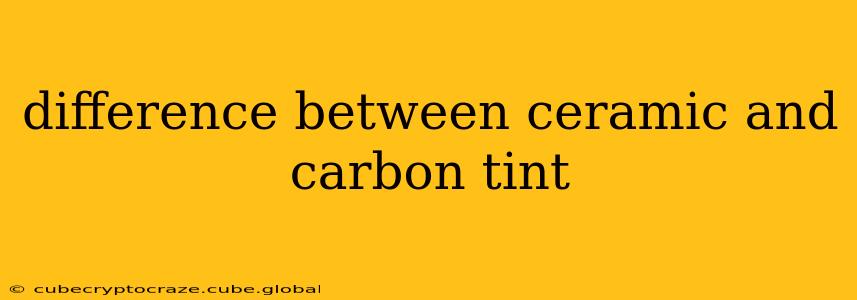Ceramic vs. Carbon Tint: Unveiling the Key Differences
Choosing the right window tint for your car can significantly impact its appearance, comfort, and even resale value. Two popular options often top the list: ceramic and carbon tint. While both offer UV protection and heat reduction, they achieve this through different methods, resulting in key distinctions in performance, longevity, and cost. This article delves into the core differences between ceramic and carbon tints, helping you make an informed decision.
What is Ceramic Tint?
Ceramic tint utilizes microscopic ceramic particles embedded within a polyester film. These particles are designed to reflect infrared (IR) radiation—the primary source of heat from the sun—while allowing visible light to pass through. This results in superior heat rejection compared to traditional dyed or metallic films. Think of it as a sophisticated sun shield at a microscopic level.
What is Carbon Tint?
Carbon tint, also known as carbon film, uses layers of carbon-based materials to block solar radiation. These layers are bonded together to form a film that is applied to your car windows. While effective in reducing heat, it generally doesn't offer the same level of heat rejection as ceramic tint, particularly in the infrared spectrum.
Key Differences: A Head-to-Head Comparison
| Feature | Ceramic Tint | Carbon Tint |
|---|---|---|
| Heat Rejection | Excellent, superior to carbon | Good, but generally less than ceramic |
| UV Protection | Excellent, blocks up to 99% of harmful UV rays | Good, blocks a significant portion of UV rays |
| Signal Interference | Minimal to none | Minimal, but potentially more than ceramic |
| Appearance | Non-metallic, clearer look | Slightly darker, more noticeable metallic sheen |
| Durability | Generally more durable, longer lifespan | Moderate durability, shorter lifespan potential |
| Cost | Typically more expensive | Generally less expensive |
What is the difference in the way they look?
Ceramic tint generally offers a clearer, more natural look to your windows. It's less likely to produce a noticeable metallic sheen or interfere with the appearance of your car's interior. Carbon tint, on the other hand, can have a slightly darker appearance and sometimes exhibits a subtle metallic shimmer. The exact look depends on the specific tint film and its concentration.
Which type of tint is more durable?
Ceramic tints are generally considered more durable and longer-lasting. Their resistance to scratching and fading is often superior to carbon tints. While both will eventually degrade over time due to sun exposure, ceramic tends to retain its performance and appearance for a longer period.
Do tints interfere with electronic signals?
Both ceramic and carbon tints have the potential to interfere with electronic signals, such as those from GPS or radio reception. However, ceramic tints typically cause less interference due to their non-metallic composition. The level of interference can vary greatly depending on the tint's composition and the strength of the electronic signals.
Which tint is better for heat reduction?
Ceramic tint wins when it comes to heat reduction. Its superior infrared radiation rejection properties translate to a cooler car interior, particularly during intense sunlight. While carbon tint provides some heat reduction, it's not as effective as ceramic in mitigating the heat build-up inside the vehicle.
Which is better: Ceramic or Carbon Tint?
The "better" tint depends entirely on your priorities and budget. If superior heat rejection, durability, and a clearer appearance are top priorities, ceramic tint is the better choice, despite its higher cost. If you're on a tighter budget and still desire some heat reduction and UV protection, carbon tint represents a more affordable alternative. Consider consulting with a professional window tinting installer to discuss your specific needs and preferences before making a decision. They can assess your car and recommend the most suitable option.
